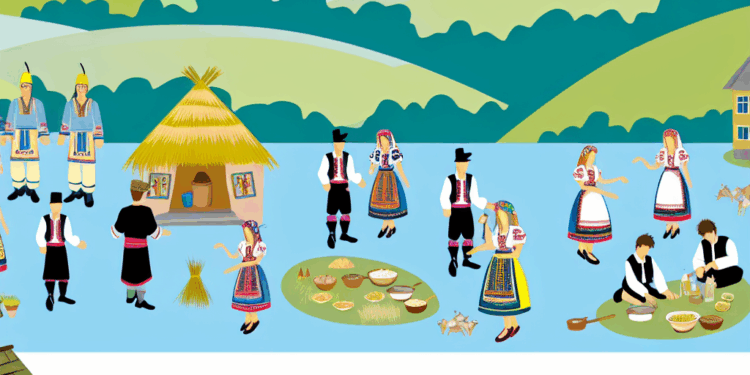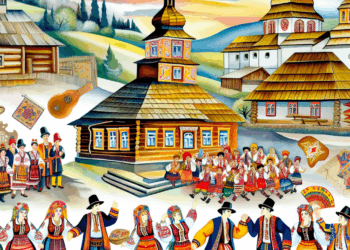Introduction
Bukovyna is a unique region located at the crossroads of cultures and peoples, where traditions, customs and craftsmanship have been developed over the centuries. This region is rich in history and its cultural heritage contains elements of Ukrainian, Romanian, Jewish and Polish cultures. In this article we will take a closer look at the traditions, folk costumes, crafts, festivals, music and folklore of Bukovina, and analyse how the multinational heritage has shaped the region.
Historical context
Bukovina is a land where history has left a deep mark. Since ancient times, this region has been a place of concentration of different ethnic groups. It was part of various states, including Galicia, Moldavia, Austria-Hungary and Romania. These influences are visible not only in architecture, but also in culture, language and traditions.
Traditions and customs
The culture of Bukovina was formed on the basis of agrarian and craft traditions of the local population. It is permeated with customs that have been handed down from generation to generation. For example, the celebration of winter and spring rituals is closely linked to the rural rhythms of life.
The “Kolyada” rite
During the winter period, Bukovina celebrates the holiday Kolyada, which includes songs, dances and ritual actions. Young people go round the houses singing carols, which symbolises the hope for good luck and prosperity in the new year. It is a festival of fellowship, in which both children and adults participate by saying good wishes.
Folk costumes
Folk costumes of Bukovina are diverse and beautiful. They show the richness and diversity of the local culture. Depending on the region, folk costumes may differ in their design and colouring.
Men’s and women’s outfits
A man’s folk costume usually consists of a shirt cinched with a belt, a wool Jacket and high boots. Women’s costumes are decorated with embroidery and lace, with a shawl draped over the shoulders and a wreath of fresh flowers or artificial flowers on the head.
Examples
For example, in villages in the north of Bukovina, the Luzhanka team uses traditional costumes with unique embroideries that reflect the cultural characteristics of their villages. Women in these costumes look particularly spectacular at festivals and holidays, such as the “Bukovyna Culture Day”.
Crafts
The handicrafts of Bukovina also reflect the diversity of cultural influences. Craftsmen here are engaged in weaving, blacksmithing, clay plastics and woodcarving.
Weaving
Weaving is one of the main craft traditions of Bukovina. Women weave cloth for clothing and household needs, using various techniques and motifs characteristic of the region. The fabrics are often hand embroidered, which adds to their uniqueness.
Wood carving
Wood carving in Bukovina also has deep roots. Craftsmen create amazing wooden items, from furniture to church iconostases. One of the famous masters is Nestor Shevchuk, who works in traditional carving techniques and makes high quality wooden products.
Music and folklore
Music and folklore are important components of Bukovina’s culture. The region is famous for its melodies that convey the mood, customs and traditions of the people.
Instruments
Traditional music uses instruments such as cymbals, tambourine, sopilka and guitar. The cymbals, for example, play an important role in wedding ceremonies, creating melodies that are played throughout the celebration.
Folklore
Folklore songs and dances are a way of preserving the historical memory of Bukovina. For example, the cheerful dances “Hutsulka Xenya” and “Perezvon” are part of wedding rituals and other celebrations. These dances help to preserve not only traditions, but also the spirit of the community.
Holidays
Holidays in Bukovina are not only a time of joy, but also an opportunity to strengthen ties between different ethnic groups. They unite the local population and attract tourists.
Bukowina Culture Day holiday
This event takes place on the first Sunday of September and gathers many participants from all over the region. You can hear songs and watch dances performed by folk groups. Craftsmen present their works and there are also master classes for everyone.
Eid al-Adha holiday
The Muslim population of Bukovina celebrates Eid al-Adha. It is a traditional Islamic holiday that unites members of the community for prayer and socialising. The holiday symbolises sacrifice and unity.
Influence of cultures
The culture of Bukovina has been shaped by numerous peoples, such as Ukrainians, Romanians, Jews and Poles. Each of these peoples has left its mark on the traditions, art and life of the region.
Ukrainian culture
Ukrainian culture plays a key role in Bukovina. Many traditions, rituals and festivals stem from Ukrainian folk culture. The use of embroidery, musical instruments and wedding rituals are all part of the Ukrainian heritage.
Romanian culture
Romanian influence is also evident in architecture, language and cuisine. Romanian folk dances and songs have enriched the musical traditions of the region. For example, the Bratlasan dance has become a symbol of unity between different ethnic groups.
Jewish culture
The Jewish population of Bukovina has also left its mark on the culture. This is reflected in the local architecture, language and cuisine. Jewish holidays and customs such as Hanukkah and Passover are still celebrated in some communities. A famous Jewish writer who hails from Bukovina is Itzik Mangei.
Polish culture
Polish culture is also reflected in Bukovina, particularly in gastronomic traditions and architectural elements. Polish folklore motifs in music and dance create an atmosphere of festivity and joy.
Conclusion
The culture of Bukovina is a unique synthesis of traditions and customs of different peoples. This multinational region preserves and transmits its traditions from generation to generation, thus enriching the modern society. Traditional holidays, folk costumes, crafts and folklore reflect the richness and diversity of local culture.
It is important to remember that the culture of Bukovina is not only the heritage of one nation, but the result of coexistence and mutual influence of different ethnic groups. This makes it one of the most colourful and interesting cultures in Ukraine and Romania, which should be preserved and developed for future generations.








